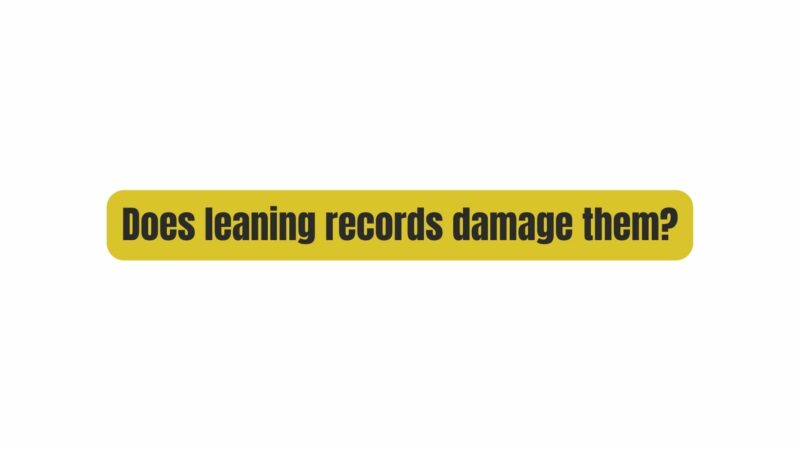In the realm of analog music, vinyl records hold a special place. With their warm, nostalgic sound and tactile appeal, they have found a dedicated following among audiophiles and collectors. But what about the seemingly harmless act of leaning records against each other or against a wall? Does leaning records damage them? In this in-depth exploration, we will dissect the structural makeup of vinyl records, examine the potential consequences of leaning them, and provide guidance on how to care for your cherished vinyl collection.
I. Understanding the Anatomy of Vinyl Records
To comprehend whether leaning records can cause damage, it’s essential to have a foundational understanding of the components that make up a vinyl record:
- Vinyl Disc: The vinyl disc itself is the circular medium on which audio is recorded. Common sizes include the 12-inch LP (long-playing) and the 7-inch single.
- Grooves: Audio content is stored in grooves etched into the vinyl surface. These grooves spiral from the record’s outer edge toward the center, containing the music’s physical representation.
- Label: The center of the record features a label displaying essential information, such as the album title, tracklist, and artist details.
- Dead Wax: The area between the final track’s groove and the label is known as the “dead wax.” It typically contains no audio information.
II. The Vulnerability of Vinyl Records
Vinyl records are renowned for their sonic qualities, but they are also known for their fragility. Several factors contribute to their vulnerability:
- Material Composition: Vinyl records are made of a brittle material that can shatter or crack when subjected to stress.
- Thinness: Records are relatively thin, making them less structurally robust compared to other materials.
- Groove Depth: Grooves on vinyl records are shallow and intricately etched, making them susceptible to damage that can affect playback.
- Weight Distribution: Records have a circular shape with an empty center, making them prone to warping and breakage if force is applied unevenly.
Given these vulnerabilities, it’s understandable why collectors and enthusiasts may be concerned about leaning records.
III. The Consequences of Leaning Records
Leaning records, especially if done haphazardly or with insufficient support, can lead to various negative consequences:
- Surface Scratches: Leaning records against each other or against a rough surface can result in surface scratches or scuffs that create audible pops and crackles during playback.
- Groove Damage: The grooves, where the audio information resides, are particularly sensitive. Scratches or damage to these areas can lead to skips, distortions, or even rendering tracks unplayable.
- Warping: Leaning records improperly can cause warping, where the record is no longer flat and does not sit evenly on the turntable. Warped records can be difficult to play correctly and may cause tracking issues.
- Increased Static Electricity: When records are leaned against each other, they can accumulate static electricity, which attracts dust and debris, potentially affecting playback quality.
- Reduction in Resale Value: For collectors, any damage to a vinyl record, including that caused by improper leaning, can significantly diminish its resale value.
IV. Best Practices for Storing and Displaying Vinyl Records
To safeguard your vinyl records and preserve their condition, it’s crucial to adopt proper storage and display practices:
- Store Vertically: Keep records stored vertically, like books, to prevent warping. Use record storage crates or shelving designed for vinyl records.
- Inner and Outer Sleeves: Invest in anti-static inner sleeves and outer jackets to protect your records from dust, scratches, and static electricity.
- Clean Records Regularly: Clean your records regularly using a suitable record cleaning brush or machine to remove dust and debris.
- Avoid Leaning Records: Avoid leaning records against each other or against surfaces that could potentially damage them. Opt for dedicated storage solutions that provide proper support.
- Use Record Dividers: Utilize record dividers or inserts to keep records separated and prevent direct contact between them.
- Climate Control: Store records in a controlled environment with stable temperature and humidity levels to minimize the risk of warping or degradation.
V. The Resurgence of Vinyl and Preservation
In recent years, there has been a remarkable resurgence of interest in vinyl records, driven by a renewed appreciation for analog audio quality and the tangible music experience they offer. The vinyl revival is characterized by several factors:
- Audiophile Appeal: Audiophiles appreciate the warm, analog sound quality that vinyl records provide, setting them apart from digital formats.
- Tangibility: Vinyl records offer a tactile and multisensory listening experience, from handling the record to cuing the stylus.
- Collectible Nature: Vinyl records, especially rare and limited editions, have gained value as collectibles, creating a thriving market.
- Nostalgia: Vinyl records evoke nostalgia for older generations and captivate younger generations intrigued by the format.
- Album Artwork: Larger album artwork and the physical presence of vinyl records contribute to their aesthetic appeal and visual impact.
As vinyl continues to thrive, the preservation of vinyl records becomes increasingly essential for collectors and enthusiasts.
VI. Conclusion
In exploring whether leaning records can cause damage, we have examined the structural vulnerabilities of vinyl records, the potential consequences of improper leaning, and the best practices for caring for your vinyl collection. Vinyl records are more than just a medium for music; they are tangible artifacts that connect us to the past and engage our senses in a unique way.
So, the next time you handle or display a vinyl record, remember the delicate balance between vulnerability and resilience—a balance that underscores the enduring magic of vinyl and the commitment to preserving its legacy for generations to come.


